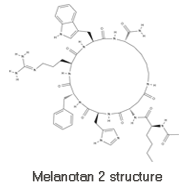6 common used peptide modification methods
Peptides have been extensively produced as an important component of pharmaceutical products, involving various bioactive substances with cellular functions in the organism. Peptide modification is an important means of altering the main chain structure and side chain groups of peptide chains, thereby altering the physical and chemical properties of peptide compounds and playing an increasingly important role in solving their effective utilization in the body, At present, a large number of experiments have shown that modified peptide drugs can significantly reduce immunogenicity, reduce toxic side effects, increase water solubility, prolong decay cycles, change their biological distribution, and significantly improve the efficacy of the drug.
There are many types of peptide modifications, and here we will briefly introduce several common modification methods:
1. PEG peptide conjugates
The most commonly used PEG modification of peptide compounds is monomethoxy polyethylene glycol (mPEG: CH3O2 (CH22CH2O) n2H). This modification involves introducing active groups such as carboxyl and amino groups at the end of mPEG, or preparing amino acid derivatives modified with mPEG, and then coupling them to the peptide sequence using solid-phase or liquid-phase methods to achieve polyethylene glycol modification of the N-terminal, C-terminal, and certain amino acid side chains of the peptide.
2. Glycopeptide
The product of glycosylation modification of peptides is called glycopeptides, which can play an important role as a modeling tool in scientific research on the structure and function of glycoproteins. Therefore, the synthesis of glycopeptides is particularly important. At present, there are mainly C -, N -, O - and S - glycosidic bond between oligosaccharides and polypeptide chains, of which N -, O - glycosidic bond are most widely used. The chemical instability of glycosidic bond greatly increases the complexity of peptide synthesis. The glycosidic bond is usually hydrolyzed under acidic conditions, and for all glycosylserine and threonine derivatives, even under very weak alkaline conditions, it also occurs β Possibility of elimination reaction
3. Phosphopeptide
The phosphorylation and dephosphorylation of proteins regulate almost all processes of life activities, including cell proliferation, development, differentiation, neural activity, muscle contraction, metabolism, and tumorigenesis. Phosphoropeptides are the best model to reflect the structural changes of their parent protein phosphorylation process. According to the different phosphorylated amino acid residues, phosphorylated peptides can be divided into four categories, namely N-phosphorylated peptides, O-phosphorylated peptides, acylphosphate peptides, and S-phosphorylated peptides. O-phosphorylated peptides are formed through the phosphorylation of hydroxyl amino acids, such as serine, threonine or tyrosine, hydroxyproline or hydroxylysine phosphorylation; N-phosphoacylated peptides are formed through the phosphorylation of arginine, lysine, or histidine; Acyl phosphate peptides are formed through the phosphorylation of aspartic acid or glutamic acid; And S-phosphoacylated peptides are formed through the phosphorylation of cysteine.
4. Cyclic peptide
Cyclic peptides can be divided into two categories: homocyclic peptides, where amino acids are linked by amide bonds; Another type is heterocyclic peptides, which have ester bonds, ether bonds, thioester bonds, and disulfide bonds in addition to amide bonds.

(peptide from Omizzur custom peptide synthesis )
Short linear peptides are easily degraded by various biological enzymes in vivo, and the formation of cyclic peptides can improve the enzymatic and chemical stability of peptides. Since the cyclic peptide has no C end and N end, it can eliminate or reduce the degradation of aminopeptidase and carboxypeptidase, thus improving the anti enzymatic ability of the peptide; At the same time, due to the formation of a circular structure, it increases the conformational limitation, which may increase the affinity and selectivity between peptides and receptors, improve activity, and reduce side effects. This is a new direction in the development of new drugs in recent years.
5. Fluorescence modified peptide
Fluorescent labeled peptides combined with imaging technology can be used to identify specific targets. In vitro imaging using confocal or fluorescence microscopy is still one of the most effective methods for studying various biological processes and interactions within cells. Unlike proteins, these peptides are located at specific targets on actin and are not easy to aggregate proteins, so they are very suitable for in vitro tracking. Similarly, FITC labeled CPP can also be used for imaging intracellular components with low cytotoxicity.
For longer sequences, it is recommended to use FRET pairs (fluorescence response energy transfer pairs) for modification. Fluorescence Resonance Energy Transfer (FRET) is a mechanism that describes the energy transfer between two fluorescent groups. Due to the fact that FRET efficiency is partially based on the distance between donor and receptor molecules, this technique is typically used to study enzyme efficiency, protein protein interactions, or other molecular dynamics.
6. Carrier protein coupling and MAPs
The peptide carrier protein junction is mostly used to prepare antitoxin antibodies. A single one is usually small enough to stimulate adequate immune response, while carrier proteins with many antigenic epitopes are conducive to stimulating helper T cells and further inducing B cell immune response. Generally, conjugated large proteins include BSA, KLH, and OVA.
Multiple antigenic peptides (MAP) are artificially branched peptides, with Lys residues serving as scaffold cores to support the formation of ≤ 8 branches with different or identical peptide sequences. Multiple antigenic peptides have been used to produce antibodies for immunological research. MAP has a high peptide antigen to core molecule molar ratio and does not require a carrier protein to trigger antibody responses.
>> For peptide and peptide impuritiy synthesis
Read Related Articles:
Copyright © 2020 Omizzur Inc | Terms & Conditions | Privacy Notice | Sitemap